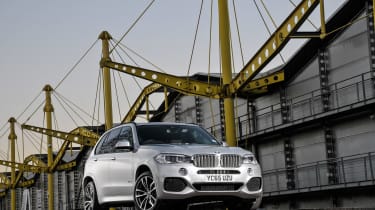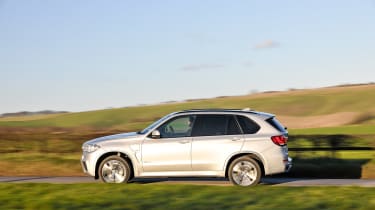BMW X5 (2013-2018) review - bulky but very capable - BMW X5 ride and handling
Good to drive and practical, but the X5's ever-increasing size counts against it in a few areas
Ride and handling
There’s a lot going for the X5 when you look at the spec sheets. The xDrive system is now lighter than before while adding Dynamic Performance Control brings an electronic (fake) limited-slip differential with torque vectoring at the back. It’s more aerodynamic too, with some X5 models as slippery as 0.31; not bad for a tall, bluff SUV like this. Aero Curtains, Air Breathers and Air Blades all work to improve the way the X5 cuts through the atmosphere to help with refinement.
And when it comes to suspension, there are enough options to make your head spin. Standard set-up is steel springs, regular shock absorbers and passive anti-roll bars, but there are no less than four more advanced packages that incorporate variable dampers, active roll bars and air springs: Adaptive Comfort; Adaptive M; Adaptive Dynamic; and Adaptive Professional. All of these have at least some on-board adjustability of the way the X5 traverses terrain, allowing you to choose on the Driving Experience Control switch whether you want comfort or taut body control.
The problem is, none of this works as well as hoped. Sure, the X5 is agile and sharper in the corners than a lot of cars in this class, but it is no longer head and shoulders above the opposition in terms of dynamics; indeed, the Porsche Cayenne is a much more involving SUV. The BMW is let down by its electrically powered assisted steering, which never quite matches feel to the amount of weight it can summon up. It also has a few degrees of ‘dead’ travel around centre.
And the ride isn’t the last word in refinement either, especially if the car is on larger alloys and running in one of its more dynamically orientated suspension modes. Keep it in Comfort and it’s better at isolating its occupants from the road surface, but again, there are rivals that do this to near perfection – the full-sized Range Rover and new Volvo XC90 among them.
Finally, sDrive models don’t lose a lot in terms of grip on tarmac compared to the xDrive cars in the dry. However, they don’t add any extra driver interactivity by the same score and some of the X5’s modest off-road capabilities are lost too. Best to specify an all-wheel drive X5, then.




